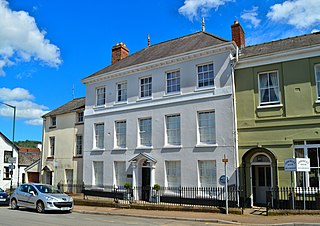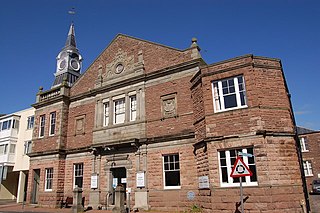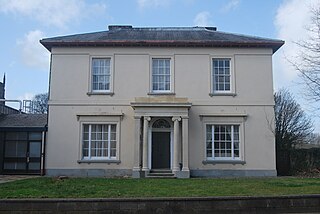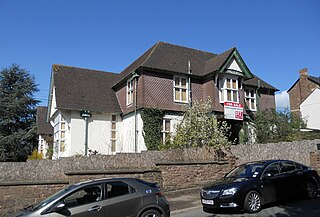History
The position of Mayor in Monmouth was established in the thirteenth century by the people who were controlling the town's market. A seal was obtained from King Henry III confirming the rights and privileges of the position and the right to also establish bailiffs for the town. The position was confirmed in 1447 when Henry VI granted a charter to the town which permitted the town to raise taxes to pay for the town and also gave some freedom from the King's taxes. (Henry VI's father had been born in the town.) This charter confirmed the position of mayor as an annual elected position and agreed that two maces should be carried before the elected person. These maces survive and carry the arms of the Duchy of Lancaster. [1]
An elected mayor and bailiffs came to lead this body and by the middle of the thirteenth century a seal had been acquired from King Henry III with certain privileges. The office of mayor can be dated from this time. [1]
John Speed mentions the position again in 1611 when he itemises the authorities as a mayor, two bailiffs and fifteen councillors. This list is still true in 2012. [1]
In 1813 that was a court case concerning the over the influence of the Duke of Beaufort in the appointment of Mayors of Monmouth. The case was won by a team including local historian, Charles Heath but the Duke found other ways of gaming the system. Heath eventually became Mayor in 1819 and 1821.
In 1835 the Municipal Corporations Act adjusted the powers but identified 1666 as the defining date of Monmouth's last charter.
William Sambrook who was a local chemist and a keen supporter of Monmouth Baptist Church was elected Mayor of Monmouth nine times. [2]

Monnow Bridge, in Monmouth, Wales, is the only remaining fortified river bridge in Great Britain with its gate tower standing on the bridge. Such bridge towers were common across Europe from medieval times, but many were destroyed due to urban expansion, diminishing defensive requirements and the increasing demands of traffic and trade. The historical and architectural importance of the bridge and its rarity are reflected in its status as a scheduled monument and a Grade I listed building. The bridge crosses the River Monnow 500 metres (1,600 ft) above its confluence with the River Wye.

Monmouth School for Boys is a public school for boys in Monmouth, Wales. The school was founded in 1614 with a bequest from William Jones, a successful merchant and trader. The School is run as a trust, the William Jones's Schools Foundation, by the Worshipful Company of Haberdashers, one of the livery companies, and has close links to its sister school, Haberdashers' Monmouth School for Girls. In 2018, the Haberdashers renamed their group of schools in the town, the Monmouth Schools, and made corresponding changes to the names of the boys' and girls' schools.

John Allan Rolls, 1st Baron Llangattock, was a Victorian landowner, Conservative Party politician, socialite, local benefactor and agriculturalist. He lived at The Hendre, a Victorian country house north of Monmouth.

Llangattock-Vibon-Avel is a rural parish and former community, now in the community of Whitecastle in Monmouthshire, south-east Wales, in the United Kingdom. It is located 5 miles (8.0 km) west of Monmouth and some 13 miles (21 km) east of Abergavenny, just off the B4233 old road between the two. Villages within the former community include Llangattock itself, Skenfrith, Rockfield, and Newcastle.

The Monmouth Museum, previously known as The Nelson Museum and Local History Centre, was a museum in Monmouth, Monmouthshire, south east Wales. It featured a collection of artefacts associated with Admiral Horatio Nelson, and a local history collection. The museum was located in the Market Hall in the town centre. It was closed during the COVID-19 pandemic in the United Kingdom and did not re-open thereafter. In 2021 Monmouthshire County Council announced plans to move the museum collection to the Shire Hall in Agincourt Square. The five-year project, supported by the National Lottery Heritage Fund, will see a new museum open at the Shire Hall by 2027. The Market Hall site will be let as commercial premises.

The Dispensary is a Georgian town house which is fairly typical of many town-centre houses in Monmouth, Wales, dating from the mid 18th century, but with early 19th-century additions. It stands in St James Square, opposite the Catalpa tree. The building was listed at Grade II on 27 June 1952.

St Mary's Priory Church, in Whitecross Street, Monmouth, Monmouthshire, Wales, is an Anglican church founded as a Benedictine priory in 1075. The current church dates mostly from the 18th and 19th centuries. It was designated a Grade II* listed building in 1952. It is one of 24 buildings on the Monmouth Heritage Trail.

The Rolls Hall, Whitecross Street, Monmouth, Monmouthshire is a Victorian hall, now public library, donated to the town in celebration of Queen Victoria's Golden Jubilee by John Rolls, the future Lord Llangattock. It is a Grade II listed building as of 8 October 2005, and is one of 24 buildings on the Monmouth Heritage Trail.

Oak House is a Grade II Listed building on Monk Street Monmouth, Wales.

Agincourt Square is an open space in the centre of Monmouth, Wales, in front of the Shire Hall. The area has been used for public functions and markets over the centuries.

Georgiana, Lady Llangattock,, born Georgiana Marcia Maclean and after her marriage termed Georgiana Marcia Rolls, was a socialite, benefactor and an enthusiast for Horatio Nelson and associated naval heroes. She was the wife of John Rolls, 1st Baron Llangattock, a Victorian landowner, Member of Parliament and agriculturalist. She and her husband lived at The Hendre, a Victorian country house north of Monmouth.

The Rolls family were substantial landowners and benefactors in and around Monmouth in south-east Wales. The ascent of the family to the aristocracy was through marriage. A prominent member of the family was Charles Stewart Rolls, who co-founded the Rolls-Royce car manufacturing company.

The Cottage Hospital was a community hospital on the Hereford Road in Monmouth, Wales.

Kingsley House and Hendre House are a pair of 19th-century, semi-detached houses on the North Parade section of Monk Street in Monmouth, Monmouthshire, Wales. The grade II listed houses were designed by noted Monmouth architect and builder George Vaughan Maddox, who also designed at least two of the twenty-four blue plaque buildings on the Monmouth Heritage Trail, including the Market Hall and the Monmouth Methodist Church. Hendre House should be distinguished from The Hendre, the estate of the Rolls family.

The Nelson Rooms is a grade II listed building in Monmouth, Monmouthshire, Wales. It is in the historic Glendower Street and Agincourt Street neighbourhood, within the medieval town walls. The building initially served as a gymnasium and was a gift from Lady Llangattock to the town of Monmouth. In 1924, after the benefactor's death, it reopened as the Nelson Museum, and showcased the collection of memorabilia related to Admiral Horatio Nelson that had been amassed by the baroness. The Nelson Museum moved to new quarters at the Market Hall in 1969. The former gymnasium and museum is now an apartment building.

Wye Bridge Ward was one of four wards in the town of Monmouth, Monmouthshire, Wales. Streets in the ward included St Mary's Street, Almshouse Street, St James Street, St James Square, Whitecross Street and Monk Street. The ward existed as a division of the town by the early seventeenth century, and continued into the twentieth century.

John Rolls of The Hendre was a native of Bermondsey, in Southwark, London, Surrey, England. A member of the renowned Rolls family of The Hendre at Llangattock-Vibon-Avel near Monmouth, Monmouthshire, Wales, he undertook the first of several expansions of the mansion. The Hendre was also the childhood home of his great-grandson Charles Stewart Rolls, aviation pioneer and co-founder of Rolls-Royce Limited. John Rolls was a Justice of the Peace, as well as a Lieutenant Colonel of the Loyal Southwark Volunteer Infantry.

Sarah Coysh was the heiress to the estates of the Coysh, Allen, and James families. Her marriage to John Rolls (1735–1801) illustrates one of the methods by which the renowned Rolls family of Monmouthshire, Wales, and London, England, accumulated and improved their properties and advanced their social rank during the eighteenth and nineteenth centuries.

St Cenedlon's is a parish church in the village of Rockfield, Monmouthshire, Wales. The dedication to St Cenedlon is unusual and the history of the saint is obscure. Some sources suggest that she was a daughter of Brychan king of Brycheiniog while others identify her as the wife of King Arthfael ab Ithel, king of Glywysing. The existing church dates from the Middle Ages but only the tower remains from that period. After the English Reformation, the surrounding area of north Monmouthshire became a refuge for Catholics and Matthew Pritchard (1669-1750), Roman Catholic bishop and Vicar Apostolic of the Western District is buried at the church. By the mid-19th century the church was in ruins and a complete reconstruction was undertaken by the ecclesiastical architects John Pollard Seddon and John Prichard in around 1860. St Cenedlon's is an active parish church in the Diocese of Monmouth. It is designated by Cadw as a Grade II listed building.

Trivor Farmhouse, St Maughans, Monmouthshire is a house dating from the late 17th century. Extended and reconstructed in the 18th century, it was originally the home of the recusant James family. In the 19th century it was bought by the Rolls family of the nearby Hendre estate. The house is Grade II* listed.























